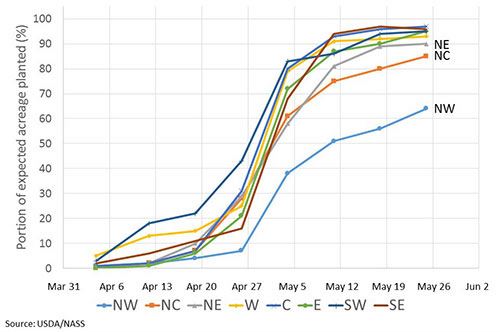Delayed Corn Planting Affects Crop Management Decisions
DR. WILLIAM J. WIEBOLD
COLUMBIA, MO.
The latest USDA report on planting progress (May 26) shows that about 15 percent of the planned corn acres in Missouri have not been planted. This is almost 500,000 acres. Most of these acres are located in northwest Missouri. The USDA report suggests that only 64 percent of the anticipated corn acres have been planted in the NW Missouri crop reporting district.
Frequent rains have slowed corn planting in nearly all of Missouri, but most locations were able to plant a majority of anticipated corn acres before the latest string of rain days. Figure 1 shows corn planting progress in eight Missouri USDA/NASS crop reporting districts from early April through late May. NW and NC districts clearly lag behind other districts for corn planting progress.
Farmers that have not completed corn planting may be considering switching from corn to soybean or keeping corn, but switching to an earlier hybrid. Both of these decisions can be complicated and depend on yield and other information that are imprecise estimates and highly dependent on weather conditions the crops experience throughout the rest of the growing season.
Yield predictions are an important part of any decision. I have conducted planting date trials for corn and soybean for at least six years. Multiple years are important because the response to planting date differs among the years. Part of the variation in response is because weather during July and August highly influence corn and soybean yields. Weather in those months cannot be predicted very well. So, we can only offer average responses. On average, yield when corn was planted on June 1 in central Missouri is 22 percent less than when planted on the optimum date. But, soybean yield is also affected by planting date. On average, yields of soybean planted on June 1 are 10 percent less than when soybean planted on the optimum date.
One consideration that faces many Midwestern farmers, but may be less important in Missouri is timing of black layer relative to frost. Black layer is an important stage when making planting date decisions because that is physiological maturity of the corn plant. At physiological maturity, corn kernels stop accumulating weight. Grain moisture is about 32 percent, so much drying needs to occur before harvest, but full yield has been reached.
Unlike soybean plants, which are highly sensitive to photoperiod, development and maturity timing of corn plants is controlled primarily by temperature and the accumulation of heat units. Growing degree days (GDD) are calculated using a simple formula that uses high and low temperatures of each day during the growing season (see http://plantsci.missouri.edu/grains/corn/calculator/about.cfm for more information).
I have a corn maturity calculator located at http://plantsci.missouri.edu/grains/corn/calculator/, but a more powerful model is located at https://mygeohub.org/groups/u2u/gdd. My calculator only estimates silking and black layer dates, whereas the U to U site also displays various freeze date scenarios. The site allows you to change parameters and see the effects of these changes on growing degree day (GDD) accumulation and black layer date.
Models are important and highly useful decision tools, but no model can take into account all the intricacies of a living plant and Mother Nature. Plant response to temperature is controlled by genes, so hybrids probably differ somewhat for their responses. Other factors such as photoperiod, the distribution of temperature throughout the 24-hour day, changing sensitivity with development stages may modify the actual response from what a model predicts.
Daily high and low temperatures decrease rapidly during October in north Missouri. For example, average high temperature decreases from 72F on October 1 to 59F on October 31 (Maryville, Nodaway County). Average GDD for October 1 is 11, but only 4 for October 31. The U to U web site provides ranges of calendar dates for black layer formation. These ranges are broad because relatively small changes in temperature can have a large effect on the predicted calendar date for black layer. This uncertainty adds to the complexity of making cropping decisions.
Farmers will also differ in their acceptance of risk. Both my corn calculator and the U to U provide estimated black layer dates if “normal” temperatures occur for the rest of the year – a situation not likely to happen. Individual farmers must determine if a 50 percent chance of frost before black layer is acceptable or is the acceptable risk closer to 10 percent. The U to U web site uses 30 years of weather data to calculate black layer dates. The range in black layer dates is often more than a month. Determining acceptable risk is an essential (but stressful) part of making cropping decisions.
Bob Nielsen, Purdue University, describes a “wrinkle” (his word) in the concept of GDD accumulation and timing of black layer stage of development (http://www.agry.purdue.edu/ext/corn/news/timeless/HybridMaturityDelayedPlant.html). He reports that corn hybrids require fewer GDDs to reach black layer when planted on June I than when planted on May 1. If true, this is good news for farmers that have corn acres to plant. Dr. Nielsen’s disclaimers are appropriate considerations. He reminds us that “hybrids undoubtedly vary in their GDD response to delayed planting” and “GDD response to delayed planting in other parts of the country may differ from what we have documented in the eastern Corn Belt”.
So where does that leave us, besides confused or with a headache? My estimation is the farmers in north Missouri should continue with corn until at least June 1. For farmers in central Missouri that date may be June 10, or later. Please remember that my estimation is based on average weather and local conditions will likely differ from average. Those differences are just as likely to be helpful as harmful, but the risk of frost before corn maturity is a possibility – a risk that increases as planting is further delayed. ∆
DR. WILLIAM J. WIEBOLD: Professor, Division of Plant Sciences, University of Missouri
